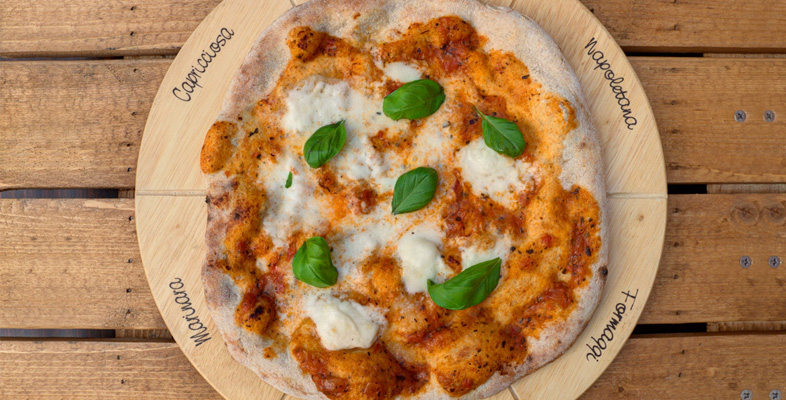6 Famous cafés
In this activity you are going to be introduced to some historic Italian coffee houses.
Activity 12
Listen to the audio track and write down the town in which each caffè is located.
Transcript
Transcript
Here is some information about some historic Italian coffee houses.
In Italia ci sono molti caffè storici. Sono eleganti e raffinati, e offrono varie specialità. Il Caffè Fiorio è a Torino. Le sue specialità sono il gelato in estate e la cioccolata calda in inverno. A Napoli c’è il Caffè Gambrinus, famoso per le sfogliatelle e i babà. È anche molto conosciuto il Caffè Florian di Venezia, dove servono il tipico liquore al caffè. Un caffè storico molto importante di Roma è il Caffè Greco, rinomato per la focaccia di polenta. Il Caffè San Marco, invece, è a Trieste. Serve gli aperitivi con gli spuntini salati.
Answer
1. Caffè Fiorio: Torino (Turin)
2. Caffè Gambrinus: Napoli (Naples)
3. Caffè Florian: Venezia (Venice)
4. Caffè Greco: Roma (Rome)
5. Caffè San Marco: Trieste (Trieste)
Skills: Listening to longer extracts
Listening to longer authentic recordings is a good way of building up your listening skills, but you shouldn’t worry if you only catch some of the words or only get a very general idea of what is being talked about. The context or instructions will help you form an idea of what to expect and, depending on the purpose of the exercise, it may be enough to listen for the gist, or you may want to focus on understanding specific information. Remember that you can do this without understanding every word; even when you listen to something in your own language you will find that you rarely hear every word, unless you are really concentrating on the message.
Here are two items of vocabulary used in the activity below.
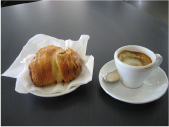 Figure 13 Una sfogliatella |
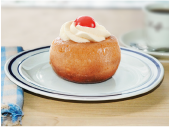 Figure 14 Un babà |
|---|
Activity 13
Listen to the audio track again and match each café with its speciality (la specialità).
Transcript
Transcript
Here is some information about some historic Italian coffee houses.
In Italia ci sono molti caffè storici. Sono eleganti e raffinati, e offrono varie specialità. Il Caffè Fiorio è a Torino. Le sue specialità sono il gelato in estate e la cioccolata calda in inverno. A Napoli c’è il Caffè Gambrinus, famoso per le sfogliatelle e i babà. È anche molto conosciuto il Caffè Florian di Venezia, dove servono il tipico liquore al caffè. Un caffè storico molto importante di Roma è il Caffè Greco, rinomato per la focaccia di polenta. Il Caffè San Marco, invece, è a Trieste. Serve gli aperitivi con gli spuntini salati.
Using the following two lists, match each numbered item with the correct letter.
-
gelato e cioccolata calda
-
sfogliatelle e babà
-
liquore al caffè
-
focaccia di polenta
-
aperitivi e spuntini
a.4. Caffè Greco
b.1. Caffè Fiorio
c.3. Caffè Florian
d.5. Caffè San Marco
e.2. Caffè Gambrinus
- 1 = b
- 2 = e
- 3 = c
- 4 = a
- 5 = d
Culture: Historic Italian coffee houses
The history of the Gran Caffè in Italy goes back to the introduction of coffee into Europe in the early seventeenth century. The first European coffee houses were established in Venice, a centre of trade between Italy and the East. The coffee houses were a meeting place for intellectuals and artists, and often became cultural landmarks. A few famous examples are the Gran Caffè Gambrinus in Naples (1860), favoured by Oscar Wilde, Ernest Hemingway and Jean-Paul Sartre, the Florian in Venice (1720), frequented by Giacomo Casanova and Charles Dickens, the Caffè Pedrocchi in Padua (1831), the Caffè degli Specchi in Trieste (1839), the Caffè Greco in Rome (1760), haunt of Richard Wagner and Orson Welles, and the Caffè Fiorio in Turin (1780), whose customers included Cavour and Nietzsche.
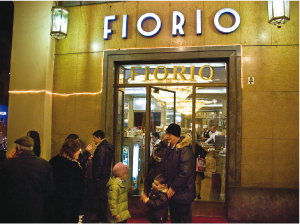 Figure 15 |
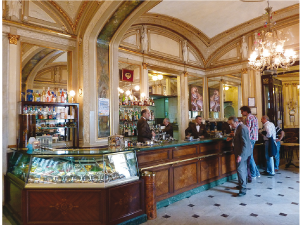 Figure 16 |
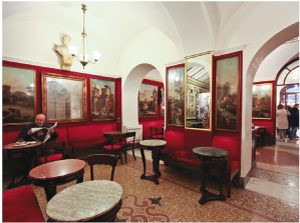 Figure 17 |
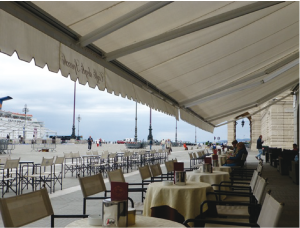 |
